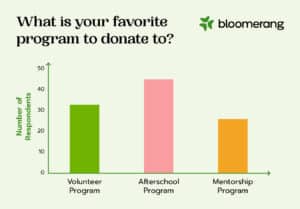
Donor engagement is essential to maintain a sustainable fundraising pipeline, but nonprofits face several retention challenges. According to Giving USA 2023, individual giving continues to drive the bulk of nonprofit funding, but the number of individual donors is shrinking.
To respond to this trend, we recommend taking your donor stewardship approach back to the basics with a tried-and-true engagement strategy — donor surveys. A donor survey is an effective tool nonprofits can use to steward supporters and access valuable insights. Use the information you gather to improve your operations and better serve your community.
We’ve compiled these tips to help you create more useful and intentional donor surveys:
- Set specific goals.
- Choose survey recipients intentionally.
- Include a mix of question types.
- Pinpoint patterns and trends.
- Thank respondents and keep them informed.
Whether you’re looking to better engage supporters, improve your fundraising campaigns, or set your nonprofit up for success in the new year, these tips will help you create engaging surveys that get more responses.
1. Set specific goals.
Every survey you create should be tied to a specific question you want to answer or type of data you want to collect. Setting clear goals for your survey will help narrow the focus of your questions and serve your nonprofit’s larger objectives.
Consider the following examples of goals and the type of survey that would best serve each objective:
| Goal | Survey type |
| Improve donor stewardship | Donor satisfaction survey |
| Engage with new donors | Getting-to-know-you survey |
| Plan for an upcoming campaign | Donor input survey |
| Optimize your programs | Donor feedback survey |
- To improve your donor stewardship approach, send a donor satisfaction survey to assess what’s going well with your online giving process and what needs improvement.
- To better engage with new donors, send a “getting to know you” survey that asks questions about donors’ interests and giving motivations.
- To plan for a major upcoming campaign, create a survey asking donors for input on your campaign’s theme or marketing strategy.
- To optimize your organization’s programs, like your volunteer program or advocacy initiative, develop a feedback survey with questions specifically tailored to the program’s characteristics.
When your surveys have a clear purpose, you’ll receive responses that empower you to make informed and tangible improvements to your nonprofit’s operations. For example, let’s say you want to improve your online donation page’s conversion rate. According to Bloomerang’s donation page guide, mobile friendliness, accessibility, a wide variety of payment options, and convenience are a few page elements that help drive conversions.
Ask donors to rate their satisfaction and share their thoughts on each of these elements. Then, review responses to identify common feedback and changes that will have the greatest impact on your conversion rate.
2. Choose survey recipients intentionally.
Think carefully about your survey audience. Who will have the most valuable insights to share? You’ll likely send most surveys to long-time or highly engaged supporters, but there are instances where feedback from new donors is useful as well.
Follow these steps to choose the right people to send your survey:
- Use your CRM to identify recipients. Your nonprofit’s CRM is an invaluable tool for identifying survey recipients. Filter your donor data based on different criteria, such as how long they’ve been involved in your cause, the specific programs they support, their donation frequency, etc. This will help you find the right target audience that will offer the most useful survey responses.
- Explain why you’re reaching out to this group specifically. Let supporters know why you’re reaching out to them and why their experience is valuable to your data-gathering process. For instance, if you’re sending a donor satisfaction survey, you can say “We’re reaching out to you because you’re among our most dedicated long-time supporters, and we value your input.”
- Emphasize the value donors can contribute through the survey. Describe the impact of the survey on your mission. For example, you may send a survey to past event attendees with a note that says “We want to make this year’s 5K Doggie Dash the best one yet. This event directly funds our programs to help more stray animals in the community. Do you have five minutes to fill out this survey and give your feedback on your previous event experience?”
- Reach out using donors’ preferred communication platform. Increase the chances that donors will see your survey by sending it using their preferred communication method. Depending on their preferences, you might send the survey via email, text, social media, or direct mail.
Personalize your survey outreach messages with supporters’ names and references to their past interactions with your organization. For example, start your email by saying “Hi Joan, We can’t thank you enough for your $150 donation on June 7th. Do you have five minutes to provide feedback on your donation experience?”
3. Include a mix of question types.
Different question types are useful for getting different types of responses from donors. For example:
- Multiple-choice questions are helpful if you need donors to choose one option out of many. You might ask “What is your favorite program to donate to?” and list your nonprofit’s programs.
- Short answer questions allow donors to provide more context for their opinions. For instance, “Would you attend our Polar Plunge fundraising event again? Why or why not?”
- Rating questions let donors quantitatively measure their feelings about your organization. For example, “Rate the convenience of our online giving process from 1-10.”
Word your questions effectively and avoid leading questions that can result in biased survey results. For example, avoid questions like “On a scale from 1-10, how amazing was our recent fundraising gala?” Instead, say “Rate your experience at our recent gala from 1-10.”
Also, ask one question at a time to make sure all your questions get answered. Don’t ask “How did you hear about our nonprofit, and what inspired you to give?” Instead, make sure each question is distinct.
4. Pinpoint patterns and trends.
An effective donor survey analysis process allows you to gather essential information and compile responses into concrete next steps your nonprofit can take. Use these strategies to optimize your data-gathering process:
- Input survey responses into a visual chart or graph to make them easier to assess. For instance, bar charts can be useful for displaying multiple-choice and rating questions. You can easily see which choice was the most popular among respondents. Check out this example of a bar chart depicting survey responses to a question about donors’ favorite programs to give to:
Alt: Bar chart titled “What is your favorite program to donate to?” Underneath the title, there is a graph with three programs listed on the X axis — volunteer program, afterschool program, and mentorship program. The after-school program bar is the tallest, demonstrating that this was the most popular survey response.

- Identify common trends in donors’ responses. Point out common responses or feedback from donors. You could create a word cloud using donors’ responses with a free tool. A word cloud is a type of data visualization that displays the words or phrases that appear most frequently in a dataset. You can input your survey data into one of these solutions, and then see what the most common responses are. Then, determine how your nonprofit will incorporate that feedback into your strategies. Make this assessment based on what’s feasible for your organization and what changes best align with your nonprofit’s values and long-term goals.
- Don’t ignore outlier responses, but don’t let them derail your analysis process. Some outliers may be due to certain supporters feeling overwhelmingly positively or negatively about your nonprofit, but others may be due to someone filling out the survey incorrectly or a glitch. Look more closely at outlier responses to assess whether they’re from a real supporter or a glitch in the system.
Take this time to assess the effectiveness of your survey itself. Did you get the data you were looking for? If not, consider ways to adjust your questions for the next survey you send.
5. Thank respondents and keep them informed.
Donors who decide to fill out the survey take time out of their day to help your nonprofit grow. Show your gratitude by thanking them and keeping them in the loop regarding any changes you’ll implement.
To ensure donors feel appreciated, you can:
- Send a genuine thank you message. A prompt thank you email is essential to show donors your gratitude and inspire supporter loyalty.
- Offer perks, such as free merchandise. A free button, sticker, or water bottle branded to your nonprofit can be a great way to thank donors for filling out your survey.
- Follow up with a summary of the survey results. In addition to this summary, include an outline of the next actions your organization will take to address feedback so donors know you’re taking their input seriously.
You can also offer donors additional ways to stay involved with your nonprofit’s activities, such as volunteer opportunities or peer-to-peer fundraising campaigns. Supporters will appreciate the opportunity to continue engaging with your mission without a continuous expectation to donate.
With these tips, you can gather vital information to improve your nonprofit’s initiatives and build stronger relationships with your supporters. Donors will feel like members of your nonprofit’s team, leading to a greater sense of community and loyalty. Plus, they’ll likely be much more receptive to your next donation appeal because they’ll know you genuinely value and appreciate their involvement.

Author: Joshua Meyer
Joshua Meyer brings more than 20 years of fundraising, volunteer management, and marketing experience to his current role as the VP of Demand Generation for Bloomerang. As a member of the Bloomerang marketing team, Josh manages the organization’s growth marketing efforts. Through his previous roles at the Human Rights Campaign and OneCause, he has a passion for helping to create positive change and helping nonprofits engage new donors and achieve their fundraising goals.
